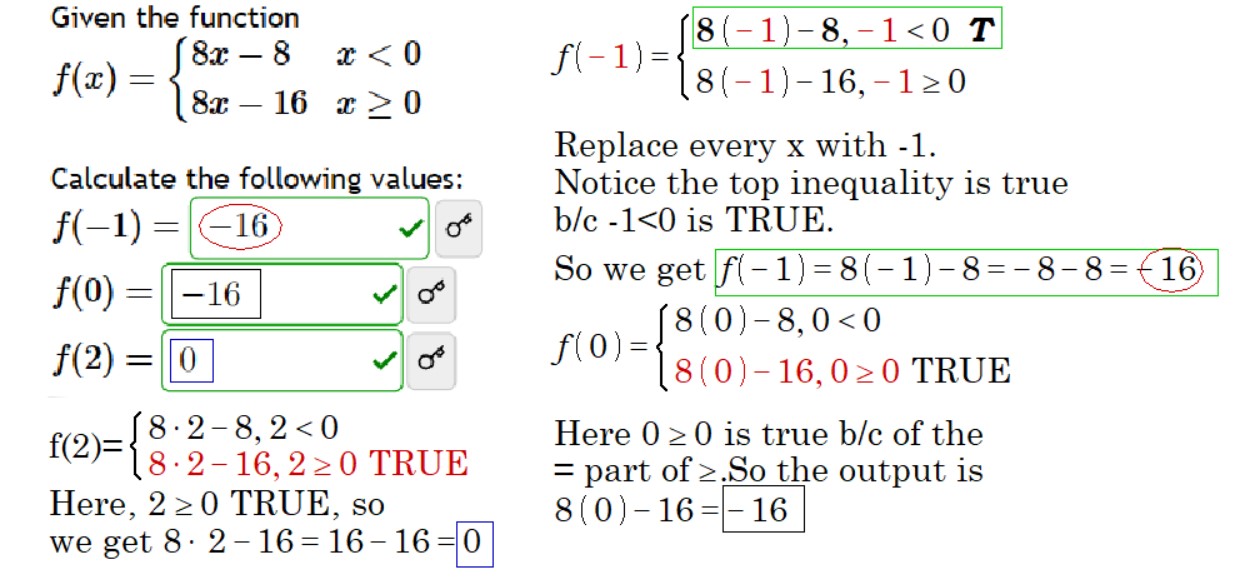Evaluating Piecewise-Defined Functions
A piecewise-defined function is a function that is defined by several different formulas, or “pieces”, each applying to a different part of the function’s domain. Evaluating these functions involves determining which “piece” of the function applies to the given input value.
Step-by-step Guide to Evaluate Piecewise-Defined Functions
- Identify the appropriate piece: Each piece of a piecewise function has a condition that specifies for which input values it applies. You need to find the piece where the condition is satisfied by the input value.
- Substitute the input value: Once you’ve identified the correct piece, substitute the input value into that piece’s formula.
- Perform the operation: Carry out any operations in the formula to find the output value.
Example
Let’s consider the following piecewise-defined function:
$$f(x) = \begin{cases} x^2 & \text{if } x < 0 \\ x + 1 & \text{if } x \geq 0 \end{cases}$$
To evaluate this function at \(x = -2\), we see that \(-2 < 0\), so we use the first piece \(x^2\). Substituting \(-2\) into \(x^2\) gives us \((-2)^2 = 4\).
To evaluate this function at \(x = 2\), we see that \(2 \geq 0\), so we use the second piece \(x + 1\). Substituting \(2\) into \(x + 1\) gives us \(2 + 1 = 3\).
Conclusion
Evaluating piecewise-defined functions may seem complex at first, but with practice, it becomes a straightforward process. The key is to identify the correct piece for the given input value and then perform the operations as defined by that piece.
Evaluating Piecewise-Defined Functions Using a Table Approach
Let’s consider the following piecewise-defined function:
$$f(x) = \begin{cases} 2x + 3 & \text{if } x < 1 \\ x^2 + 1 & \text{if } x \geq 1 \end{cases}$$
We will evaluate this function at \(x = -1\), \(x = 0\), \(x = 1\), and \(x = 2\).
| \(x\) | Condition | Formula | \(f(x)\) |
|---|---|---|---|
| \(-1\) | \(-1 < 1\) | \(2x + 3\) | \(2(-1) + 3 = 1\) |
| \(0\) | \(0 < 1\) | \(2x + 3\) | \(2(0) + 3 = 3\) |
| \(1\) | \(1 \geq 1\) | \(x^2 + 1\) | \((1)^2 + 1 = 2\) |
| \(2\) | \(2 \geq 1\) | \(x^2 + 1\) | \((2)^2 + 1 = 5\) |
As you can see, the table approach provides a clear and organized way to evaluate piecewise-defined functions at multiple points.
Evaluating Complex Piecewise-Defined Functions
Let’s consider the following piecewise-defined function:
$$f(x) = \begin{cases} 3x^2 – 2x + 1 & \text{if } x < 0 \\ x^3 + 2x^2 - x + 1 & \text{if } 0 \leq x < 2 \\ 2x^2 - 3x + 2 & \text{if } x \geq 2 \end{cases}$$
Evaluating at \(x = -1\)
Since \(-1 < 0\), we use the first piece \(3x^2 – 2x + 1\). Substituting \(-1\) into the equation, we get:
Evaluating at \(x = 1\)
Since \(0 \leq 1 < 2\), we use the second piece \(x^3 + 2x^2 – x + 1\). Substituting \(1\) into the equation, we get:
Evaluating at \(x = 3\)
Since \(3 \geq 2\), we use the third piece \(2x^2 – 3x + 2\). Substituting \(3\) into the equation, we get:
Conclusion
Evaluating complex piecewise-defined functions involves the same basic steps as simpler functions. The key is to carefully substitute the input value into the correct piece and simplify the resulting expression to find the output value.
Evaluating Piecewise-Defined Functions In-Place
Let’s consider the following piecewise-defined function:
$$f(x) = \begin{cases} 2x^2 + 3 & \text{if } x < 1 \\ x^3 - 2x + 1 & \text{if } x \geq 1 \end{cases}$$
Evaluating at \(x = -1\)
Since \(-1 < 1\), we use the first piece \(2x^2 + 3\). Substituting \(-1\) into the equation, we get:
$$f(-1) = \begin{cases} 2(-1)^2 + 3 & \text{if } -1 < 1 \\ (-1)^3 - 2(-1) + 1 & \text{if } -1 \geq 1 \end{cases}$$
$$= \begin{cases} 2(1) + 3 & \text{if } -1 < 1 \\ -1 + 2 + 1 & \text{if } -1 \geq 1 \end{cases}$$
$$= \begin{cases} 2 + 3 & \text{if } -1 < 1 \\ 2 & \text{if } -1 \geq 1 \end{cases}$$
$$= \begin{cases} 5 & \text{if } -1 < 1 \\ 2 & \text{if } -1 \geq 1 \end{cases}$$
Evaluating at \(x = 2\)
Since \(2 \geq 1\), we use the second piece \(x^3 – 2x + 1\). Substituting \(2\) into the equation, we get:
$$f(2) = \begin{cases} 2(2)^2 + 3 & \text{if } 2 < 1 \\ (2)^3 - 2(2) + 1 & \text{if } 2 \geq 1 \end{cases}$$
$$= \begin{cases} 2(4) + 3 & \text{if } 2 < 1 \\ 8 - 4 + 1 & \text{if } 2 \geq 1 \end{cases}$$
$$= \begin{cases} 8 + 3 & \text{if } 2 < 1 \\ 4 + 1 & \text{if } 2 \geq 1 \end{cases}$$
$$= \begin{cases} 11 & \text{if } 2 < 1 \\ 5 & \text{if } 2 \geq 1 \end{cases}$$
Conclusion
This in-place evaluation method shows the step-by-step process of evaluating a piecewise-defined function at specific points, keeping the structure of the function intact at each stage of the calculation.

